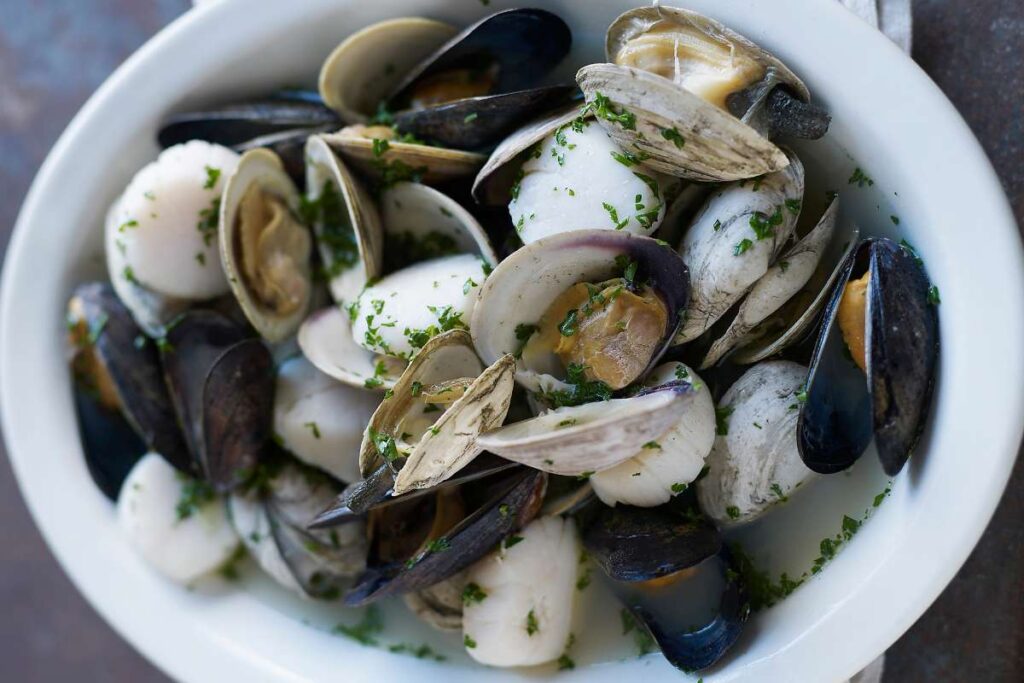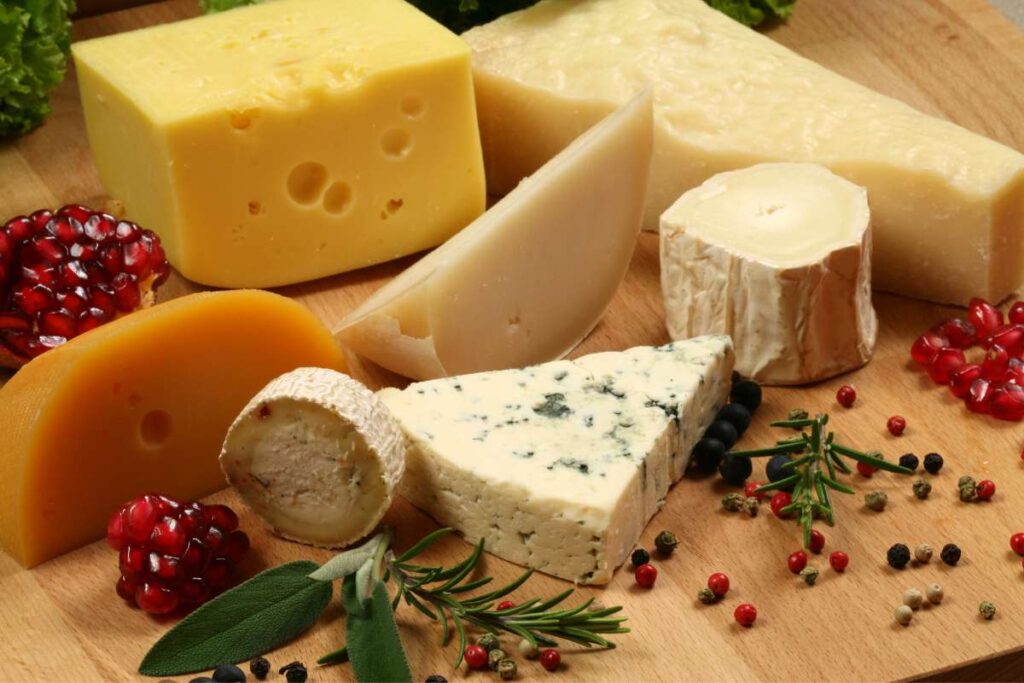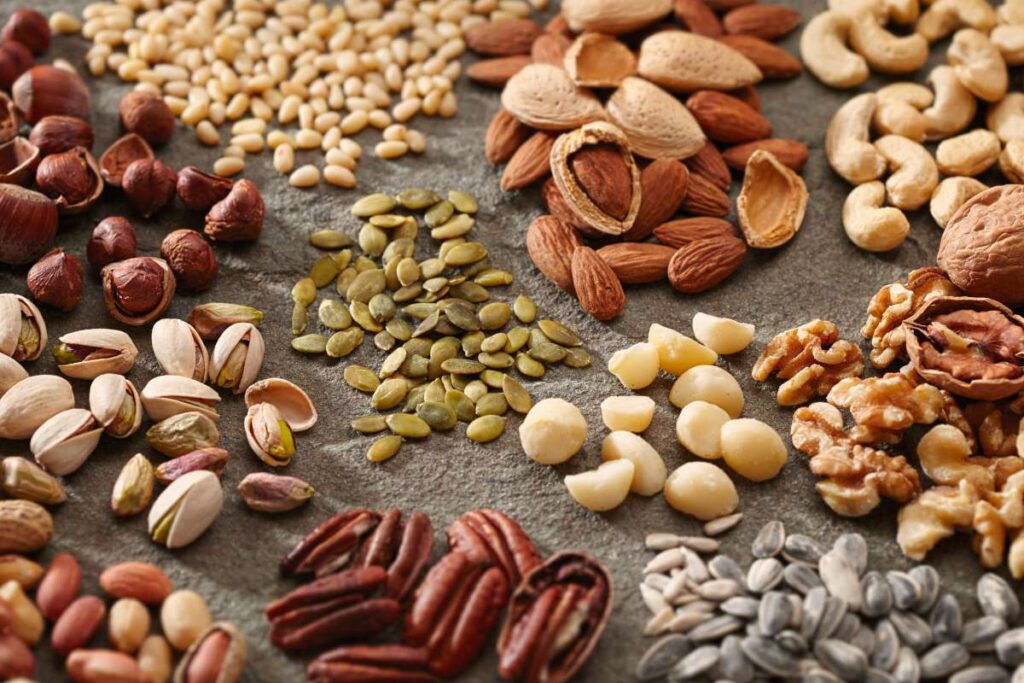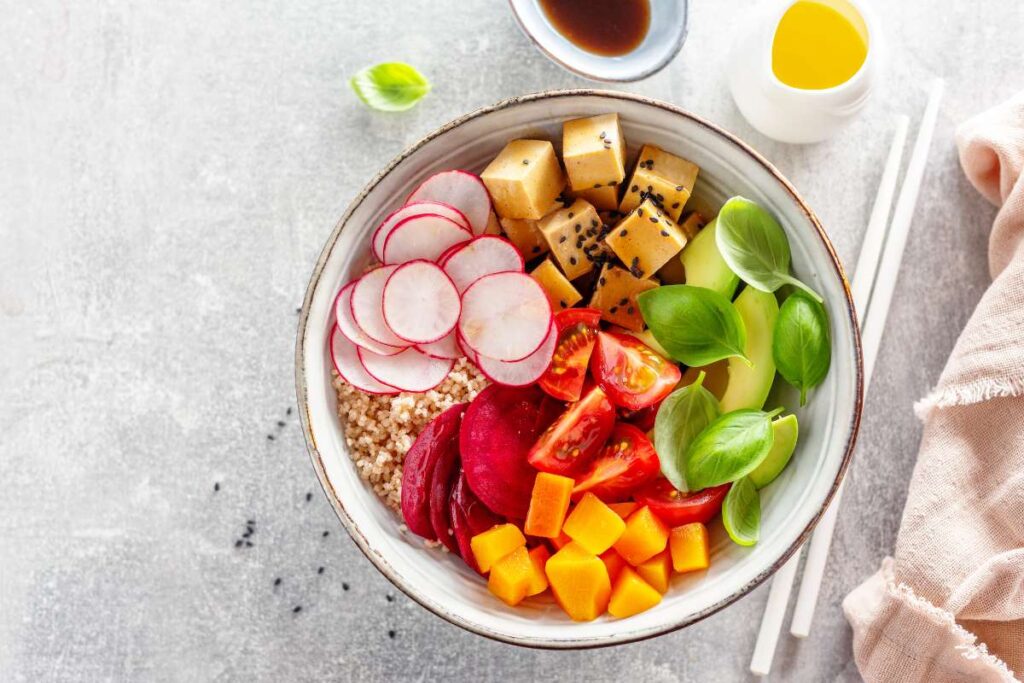This post may contain affiliate links at no additional cost to you. As an Amazon Associate I earn from qualifying purchases. Click to view our full disclosure.
What's inside
Hello, and welcome to my list of foods high in creatine.
Creatine is one of the most popular supplements available on the market thanks to its benefits for performance and muscle gain. Many people swear by adding a couple of scoops of creatine to their daily routine.
However, as a Registered Dietitian, I meet people who don’t want to take any supplements, especially creatine.
Whatever the reason, we’ll focus on including high-creatine foods to ensure they reach the recommended daily intake.
So, how can you get creatine naturally?
Most foods high in creatine come from animal sources. This means someone following a plant-based or vegan diet might struggle to get their daily creatine intake without supplementation.
Keep reading to see the 100 foods high in creatine from both animal and plant-based sources. The goal is to help reach your daily creatine intake without relying on a supplement.
What is creatine?
Related: Can You Dry Scoop Creatine?
Creatine is a substance you can naturally find in the body. It’s a combination of three amino acids: L-arginine, glycine, and L-methionine.
You can find over 95% of natural creatine in your muscles and the remaining 5% in the brain and testes.
It is one of the most explored and studied supplements worldwide, with endless benefits. Some of these include increased energy, strength, and muscle mass. However, we’ll go into detail on creatine benefits later in the article.
How does creatine work?

The short answer is that it helps produce fast and explosive energy.
There are three main types of energy systems in the body:
- Fast intensity and short duration.
- Medium intensity and medium duration.
- Low intensity and long duration.
The first energy system (fast intensity and short duration) relies on the production of phosphocreatine to create that energy. Creatine is a substance that helps increase concentrations of phosphocreatine in the muscles.
When you add extra creatine, you increase the reserves of phosphocreatine to use as an energy source. When you have more energy stored, it’s easier to be used later when you need it. Thus, improving performance.
Besides energy production, it can also help increase muscle by promoting cell hydration (more water in muscle cells), improving work volume, and reducing protein breakdown.
Creatine Benefits
There’s tons of research on creatine’s benefits. Here are a few worth noting:
Energy Production

As we’ve already seen, one of the main benefits of creatine is its effect on energy production.
By increasing phosphocreatine reserves, it can help produce ATP (the body’s energy molecule).
So, while it won’t give you immediate energy like caffeine, it can help provide you extra energy when you do short and explosive exercises like sprints or short gym sets.
Supports Muscle Growth
There are several ways in which creatine can affect the muscle.
Evidence suggests that creatine can increase the water levels inside muscle cells. This can help increase muscle size.
It can also increase the hormone insulin-growth factor 1 (a growth hormone) that helps make muscle growth achievable.
In fact, a study showed that participants who consumed creatine for six weeks had an average of 2 kg of weight gain (muscle mass) than the control group.
Improves Performance
Studies show that supplementing with creatine can help increase performance.
It seems that supplementing with creatine might help increase strength and power by 5-15%. Additionally, it seems it can increase sprint performance by 5-15%.
Boosts Brain Function
The brain requires a lot of energy to function properly. With larger phosphocreatine reserves, there is more energy available for the brain to use.
In a study, older adults who were supplemented with 5 g of creatine had improved memory at the end of the observation period.
Another study showed that supplementing with creatine reduced the risk of neurological diseases.
Can Reduce Fatigue
Adding more creatine to your diet can also have an effect on fatigue.
A study showed that in people with brain injury who were supplemented with creatine, only 10% experienced fatigue.
Helps Lower Blood Sugar
Finally, it seems that creatine might help lower blood sugar levels.
It might help increase the absorption of glucose into the muscle cells to be used as energy. As a result, it leads to lower blood glucose levels.
Research shows that people who combined creatine supplementation with aerobic exercise had better blood glucose levels than those in the control group.
100 Foods High in Creatine – Per 100g
Related: 9 Best Creatine Supplements For Women
Before we learn more specifics about foods high in creatine, let’s determine what is going to be a high creatine food.
As we are going to see later in the article, the recommendation for creatine from food sources is 1-3 g of creatine per day.
Taking the midpoint as the reference point (2 g), any food that offers at least 20% of the recommended intake of creatine (0.04 g) per 100 g is going to be considered a high-creatine food.
The following table shows 100 foods high in creatine per 100 g. From there, we’ll break all of the best creatine-rich foods into different groups for easy reference.
| No. | Food Source | Creatine (g) |
| 1 | Soy protein isolate | 11.4 |
| 2 | Powdered egg white | 10.0 |
| 3 | Pumpkin seed | 7.8 |
| 4 | Hemp seeds | 7.1 |
| 5 | Butternuts | 7.0 |
| 6 | Sesame seeds | 5.2 |
| 7 | Cuttlefish | 5.1 |
| 8 | Peanuts | 5.0 |
| 9 | Octopus | 4.7 |
| 10 | Venison | 4.5 |
| 11 | Beef | 4.5 |
| 12 | Sunflower seeds | 4.4 |
| 13 | Veal | 4.3 |
| 14 | Chicken breast | 4.2 |
| 15 | Chicken meat | 4.2 |
| 16 | Fenugreek seed | 4.1 |
| 17 | Rabbit meat | 4.1 |
| 18 | Yellowtail | 4.1 |
| 19 | Clam | 4.0 |
| 20 | Anchovy | 4.0 |
| 21 | Pork | 4.0 |
| 22 | Almonds | 4.0 |
| 23 | Mustard seed | 4.0 |
| 24 | Brazil nuts | 4.0 |
| 25 | Mussels | 3.8 |
| 26 | Pink salmon | 3.8 |
| 27 | Lamb meat | 3.8 |
| 28 | Turkey meat | 3.8 |
| 29 | Turkey leg | 3.8 |
| 30 | Trout | 3.7 |
| 31 | Chia seeds | 3.7 |
| 32 | Snapper | 3.6 |
| 33 | Atlantic salmon | 3.5 |
| 34 | Lobster | 3.5 |
| 35 | Turkey thigh | 3.5 |
| 36 | Flaxseeds | 3.5 |
| 37 | Pistachio nuts | 3.5 |
| 38 | Pollock | 3.4 |
| 39 | Sardine | 3.4 |
| 40 | Scallops | 3.4 |
| 41 | Turkey breast | 3.4 |
| 42 | Duck meat | 3.4 |
| 43 | Cashew nuts | 3.4 |
| 44 | Poppy seeds | 3.4 |
| 45 | Pine nuts | 3.4 |
| 46 | Crab | 3.3 |
| 47 | Walnuts | 3.3 |
| 48 | Mackerel | 3.3 |
| 49 | Whiting | 3.2 |
| 50 | Herring | 3.2 |
| 51 | Chicken thighs | 3.2 |
| 52 | Hazelnuts | 3.2 |
| 53 | Crayfish | 3.0 |
| 54 | Parmesan | 2.9 |
| 55 | Squid | 2.8 |
| 56 | Tuna | 2.6 |
| 57 | Romano cheese | 2.6 |
| 58 | Lupin beans | 2.4 |
| 59 | Gruyere cheese | 2.3 |
| 60 | Soy beans | 2.3 |
| 61 | Dry milk | 2.2 |
| 62 | Swiss cheese | 2.2 |
| 63 | Edam cheese | 2.2 |
| 64 | Gouda cheese | 2.2 |
| 65 | Tempeh | 2.2 |
| 66 | Provolone cheese | 2.1 |
| 67 | Fennel seed | 2.1 |
| 68 | Macadamia nuts | 1.9 |
| 69 | Pecans | 1.8 |
| 70 | Brie cheese | 1.7 |
| 71 | Blue cheese | 1.7 |
| 72 | Quail eggs | 1.7 |
| 73 | Raw eggs | 1.7 |
| 74 | Hard boiled eggs | 1.6 |
| 75 | Mozzarella cheese | 1.6 |
| 76 | Camembert cheese | 1.6 |
| 77 | Cheddar cheese | 1.6 |
| 78 | Soy bean sprouts | 1.6 |
| 79 | Raw egg white | 1.5 |
| 80 | Edamame | 1.3 |
| 81 | Chickpeas | 1.3 |
| 82 | Ricotta cheese | 1.2 |
| 83 | Peas | 1.2 |
| 84 | Firm tofu | 1.2 |
| 85 | Goji berries | 1.1 |
| 86 | Lentils | 1.1 |
| 87 | Black beans | 1.0 |
| 88 | Spirulina | 0.9 |
| 89 | Pea sprouts | 0.9 |
| 90 | Kidney beans | 0.9 |
| 91 | Laver | 0.8 |
| 92 | Lima beans | 0.8 |
| 93 | Quinoa | 0.6 |
| 94 | Wild rice | 0.6 |
| 95 | Buckhwheat | 0.6 |
| 96 | Parboiled rice | 0.5 |
| 97 | Cooked rapini | 0.4 |
| 98 | Dried bananas | 0.4 |
| 99 | Long-grain white rice | 0.4 |
| 100 | Long-grain brown rice | 0.4 |
Red Meat
- Venison: 4.5 g
- Beef: 4.5 g
- Veal: 4.3 g
- Rabbit meat: 4.1 g
- Pork: 4.0 g
- Lamb meat: 3.8 g
Poultry
- Chicken breast: 4.2 g
- Chicken meat: 4.2 g
- Turkey meat: 3.8 g
- Turkey leg: 3.8
- Turkey thigh: 3.5 g
- Duck meat: 3.4 g
- Turkey breast: 3.4 g
- Chicken thighs: 3.2 g
Seafood

- Cuttlefish: 5.1 g
- Octopus: 4.7 g
- Yellowtail: 4.1 g
- Clam: 4.0 g
- Anchovy: 4.0 g
- Mussels: 3.8 g
- Pink salmon: 3.8 g
- Trout: 3.7 g
- Snapper: 3.6 g
- Atlantic salmon: 3.5 g
- Lobster: 3.5 g
- Pollock: 3.4 g
- Sardine: 3.4 g
- Scallops: 3.4 g
- Crab: 3.3 g
- Mackerel: 3.3 g
- Whiting: 3.2 g
- Herring: 3.2 g
- Crayfish: 3.0 g
- Squid: 2.8 g
- Tuna: 2.6 g
Seaweed
- Spirulina: 0.9 g
- Laver: 0.8 g
Dairy

- Parmesan cheese: 2.9 g
- Romano cheese: 2.6 g
- Gruyere cheese: 2.3 g
- Swiss cheese: 2.2 g
- Edam cheese: 2.2 g
- Gouda cheese: 2.2 g
- Dry milk: 2.2 g
- Provolone cheese: 2.1 g
- Brie cheese: 1.7 g
- Blue cheese: 1.7 g
- Mozzarella cheese: 1.6 g
- Camembert cheese: 1.6 g
- Cheddar cheese: 1.6 g
- Ricotta cheese: 1.2 g
Eggs
- Powdered egg white: 10.0 g
- Quail eggs: 1.7 g
- Raw eggs: 1.7 g
- Hard-boiled eggs: 1.6 g
- Raw egg white: 1.5 g
Vegetables
- Butternuts: 7.0 g
- Peas: 1.2 g
- Pea sprouts: 0.9 g
- Cooked rapini: 0.4 g
Fruits
- Goji berries 1.1 g
- Dried bananas: 0.4 g
Cereals And Grains
- Quinoa: 0.6 g
- Wild rice: 0.6 g
- Buckwheat: 0.6 g
- Parboiled rice: 0.5 g
- Long-grain white rice: 0.4 g
- Long-grain brown rice: 0.4 g
Seeds and Nuts

- Pumpkin seed: 7.8 g
- Hemp seed: 7.1 g
- Sesame seeds: 5.2 g
- Peanuts: 5.0 g
- Sunflower seeds: 4.4 g
- Fenugreek seed: 4.1 g
- Almonds: 4.0 g
- Mustard seed: 4.0 g
- Brazil nuts: 4.0 g
- Chia seeds: 3.7 g
- Flaxseed 3.5 g
- Pistachio nuts: 3.5 g
- Cashew nuts: 3.4 g
- Poppy seeds 3.4 g
- Pine nuts 3.4 g
- Walnuts 3.3 g
- Hazelnuts 3.2 g
- Fennel seed 2.1 g
- Macadamia nuts: 1.9 g
- Pecans: 1.8 g
Legumes
- Soy protein isolate: 11.4 g
- Lupin beans: 2.4 g
- Soybeans: 2.3 g
- Tempeh: 2.2 g
- Soy bean sprouts: 1.6 g
- Edamame: 1.3 g
- Chickpeas: 1.3 g
- Firm tofu: 1.2 g
- Lentils: 1.1 g
- Black beans: 1.0 g
- Kidney beans 0.9 g
- Lima beans: 0.8 g
Creatine in Vegetarians and Vegans

As you’ve seen, most of the foods high in creatine come from animal products.
However, there are some good vegetarian or vegan alternatives for you to reach the desired amount. With that said, remember the table is for 100 g.
For example, 100 g of pumpkin seeds does have 7.4 g of creatine, but this would mean consuming ¾ cup of pumpkin seeds. Keep this in mind to check if it fits your calories or macro intake.
Since it is harder to reach the daily intake of creatine in vegetarians and vegans, I typically recommend adding a creatine supplement to ensure you get at least the daily minimum.
How To Use Creatine
Related: Best Creatine For Women
If you’re focusing on natural creatine sources, make sure to measure and add up the content of each food until you reach the recommended daily intake (1-3 g per day).
However, if you supplement, there are two options.
You can do a loading phase where you consume 20-25 g of creatine for seven days. Once those seven days pass, you cut back to the typical dosage of 2-5 g per day.
If you don’t want to do a loading phase, you can do a standard dose of 2-5 g each day, without any breaks.
Recommended Daily Amount
The average recommendation for creatine is 2-5 g per day. You can achieve this through the food you eat daily or by supplementing.
However, reaching this amount through food might be tough, so it’s better to strive for 1-3 g from natural creatine sources.
Also, bear in mind that the daily amount should be higher for some people. Athletes, bodybuilders, and those who exercise heavily in general might need larger doses to help improve energy and performance.
If you want to customize creatine intake to your body, the recommendation according to the International Society of Sports Nutrition is 0.03 g of creatine per kilogram of body weight.
Conclusion
That’s the rundown of foods naturally high in creatine.
Creatine has several big benefits for the body. It can help increase energy, improve performance, reduce blood sugar levels, and have brain-protective properties.
While the most common way to increase creatine stores in the body is through supplementation, some people might not want to rely on a supplement. For that reason, adding high-creatine foods is going to play an essential role in achieving your goals.
Remember to consider that the foods mentioned above are for 100 g per serving. So, make sure to make the adequate conversion to get both the necessary creatine supply combined with the necessary calories and macros you need.
Did you enjoy this list? Were there any foods here that surprised you? Let us know in the comments.
Frequently Asked Questions
What is the main source of creatine?
The main source of creatine is animal products, especially red meat. However, you can also find it in legumes, nuts, seeds, and algae. If you are unable to reach your creatine intake through food, you can always supplement.
Does heat and cooking destroy creatine?
Creatine is pretty heat-stable, but cooking might reduce 10-30% of the creatine in the food.
Creatine side effects?
Creatine is safe, but overconsumption of creatine (mainly in supplement form) can result in gastric distress like bloating, stomach cramps, and gas.
How much creatine per day?
Research recommends taking 2-5 g of creatine per day to get all the health benefits. If you are getting it only through food, you might strive for 1-3 g of creatine per day.
Does creatine make you gain weight?
Creatine can make you gain muscle mass, but it won’t make you gain fat mass.
Is creatine good for weight loss?
Yes, creatine can be helpful during weight loss since it helps preserve muscle mass. As a result, it helps keep your metabolism high, allowing you to burn more calories.
Does creatine boost testosterone?
No, research shows that creatine doesn’t have an effect on testosterone levels.

